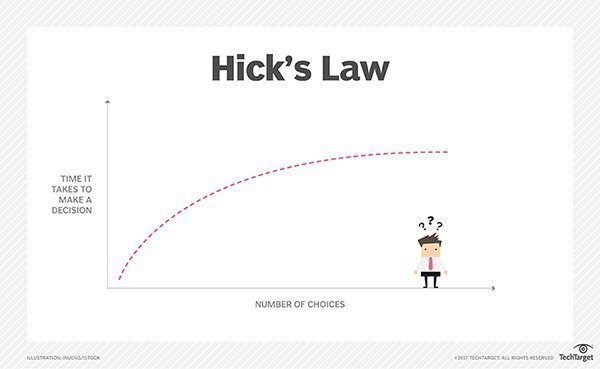How We Apply The Law Of Hick when We Make Decisions
Decision making is a complex process in which experience, emotions and will intervene. Hence, for many decades now, science has been studying the mechanisms that come into play when making a determination. Hick's Law explains this process in terms of time.
Source imagen cdn.ttgtmedia.com
The Law of Hick is a principle discovered by William Edmund Hick and Ray Hyman. It allows measuring the time it takes a person to make a decision. It suggests that the greater number of alternatives, and the greater complexity or divergence in these, obviously will increase the time necessary to reach a determination. This time follows a logarithmic pattern.
In literal sense, the Law of Hick raises the following thing: "The time that a person takes in taking a decision is proportional to the 'entropy of decision' that is to say, quantity and complexity of alternatives that exist". Decision entropy refers to the difficulties introduced by the possible options.
"I am not a product of my circumstances, I am a product of my decisions".
-Steven Covey-
The emergence of the Law of Hick and its applications
The antecedents of the Law of Hick arose at the end of century XIX. J. Merkel had discovered that when a stimulus belongs to a larger group of stimuli, people take longer to respond.
Hyck and Hyman conducted a series of experiments. Thus they were able to determine that the time it took someone to make a decision based on the number of serious alternatives they had could be calculated. All this was expressed in a mathematical formula.
Surprisingly, its main application has been in video games. The designers of these cut the time necessary to make decisions in a particular game to create tension. Or they extend the time available to relax that tension.
Source imagen webconsultas.com
Time and success
Some people think that the more time they spend making a decision, the greater the likelihood of choosing the best option. This is not entirely true. Sometimes very studied decisions are made and, nevertheless, they turn out to be incorrect. The opposite also occurs.
The Law of Hick simply allows to calculate the time to reach a decision through a universal mathematical formula. That is, it is applicable to all human beings. However, for the decision to be correct, four factors come into play:
- Experience. The experience is empirical knowledge. In general, it has a greater weight than theoretical knowledge, since it involves it, but it includes aspects of its application. Experience is perhaps the most relevant factor in making a correct decision.
- Good judgement. Good judgment means a mixture of common sense and reasoning ability, along with intellectual maturity. It corresponds to people who know how to weigh the situations and make realistic balances of them.
- Creativity. Creativity allows taking knowledge from the past and associating it with the concrete situation, to produce a new approach. A creative decision is one that innovates, to some extent.
- Quantitative skills It has to do with the ability to process the quantitative data involved in the situation on which a decision must be made. In other words, the incorporation of statistical evidence.
Practical aspects of the Law of Hick
The Law of Hick gives us, above all, a valuable criterion for making decisions. As he points out, the greater the number of options, the longer it takes someone to decide. Therefore, an intelligent strategy would be to minimize the alternatives that are taken into account.
A good way to carry it out is by listing all the available options. Then, order them by the risk they imply or the difficulty that could eventually arise. Also, specify which is the one that could generate the greatest benefit. This is a basic risk analysis and is very useful to get out of a block.
What follows simply is to choose the option that presents a greater balance between risks and benefits. This avoids falling into a vicious circle in which any decision seems possible or viable. It is a fast and effective way to approach decisions with some degree of complexity.




I like, your publication and thanks for sharing, your content, I value the emotive part and you have great reason
thank you..
You got a 94.50% upvote from @ocdb courtesy of @joelgonz1982!